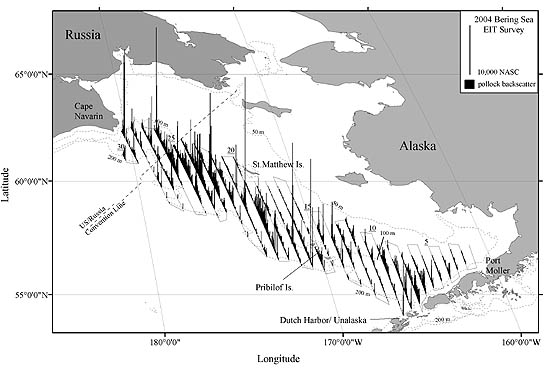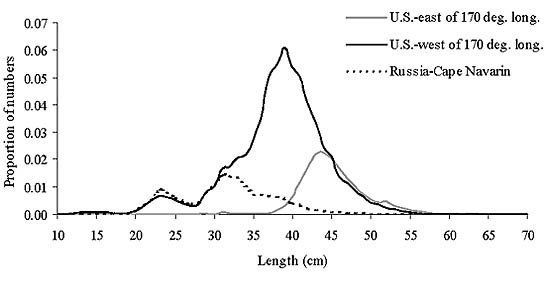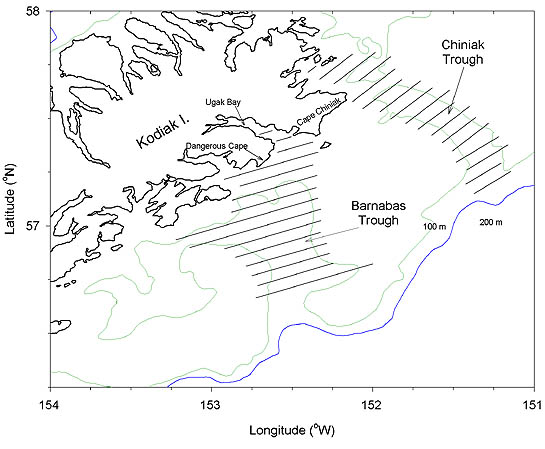Midwater Assessment & Conservation Engineering (MACE)
Bering Sea Summer 2004 Pollock EIT Survey
MACE Program scientists conducted an echo integration-trawl (EIT) survey between 5 June and 1 August 2004
on the U.S. and Russian Bering Sea shelf near Cape Navarin aboard the NOAA ship Miller Freeman. This
was the first year since 1994 that permission was granted to survey in Russian waters. The principal objective
of the survey was to collect echo integration and trawl data to estimate midwater pollock abundance and
distribution. Scientists from the AFSC’s National Marine Mammal Laboratory (NMML) were aboard to census marine
mammals along the EIT survey track during Leg 1. Four Russian scientists participated in the survey.
The planned survey design, including Russian waters, consisted of 31 north-south transects spaced 20 nmi apart
over the Bering Sea shelf from Port Moller, Alaska, to Cape Navarin, Russia. Due to the ship’s mechanical
difficulties, only the southern portion of transect 30 was completed, and transect 31 was not completed (Fig. 8
below). Echo integration and trawl data were collected during daylight hours. Nighttime operations included
additional trawling, target strength data collection, field-testing of a midwater trawl with a
multiple-opening-closing codend device, net selectivity experiments, and acoustic system testing.

Figure 8. Relative backscattering (NASC) attributed to pollock observed between 12 m
from the surface and 3 m off bottom along tracklines during the summer 2004 echo integration-trawl
survey on the Bering Sea shelf, MF2004-08. Transect numbers are underlined. |
Biological data and specimens were collected from 154 trawl hauls, which included: 117 hauls with a large
midwater trawl; 20 with a bottom trawl; 9 with a Marinovich trawl, and 8 with a Methot trawl. Walleye pollock
was the most abundant and jellyfish (Cnidaria) was the second most abundant taxon captured by weight in both
midwater and bottom trawl hauls. Jellyfish were the dominant species group by weight for both the Marinovich
and Methot trawls. Numerically, age-0 pollock dominated Marinovich catches, and euphausiids dominated Methot
catches. Trawl catches indicated that east of 170°W, pollock 38 cm to 50 cm in length were on average 8% heavier
than pollock west of 170°W. Fewer than 1% of the pollock larger than 29 cm fork length (approximately age 3 and
older) were actively spawning. Most pollock were either in the developing or post-spawning maturity stage.
Pollock were observed on all but the first transect (Fig. 8 above). In the U.S. EEZ most pollock were observed west
and southwest of St. Matthew Island (transects 20-26). In Russia’s EEZ, most were observed near the north ends
of transects 26 and 29. Preliminary abundance estimates for pollock between 12 m from the surface and 3 m off
the bottom indicated that approximately 90% of the total biomass was found in the United States and about 10%
was observed in Russia, off Cape Navarin. Of the U.S. pollock abundance, about one-third of the population was
located east of 170°W and about two-thirds was observed west of 170°W. The largest pollock were observed east
of 170°W, where the predominant length mode was 44 cm and relatively few juveniles were observed (Fig. 9 below). As
the survey continued west, the predominant length mode became 39 cm in the U.S.-west of 170°W region. Off Cape
Navarin, the predominant length mode was 31 cm, and relatively few adult pollock larger than 40 cm were observed.

Figure 9. Estimated length distribution of pollock observed between 12 m from the surface and 3 m off
bottom in three regions during the summer 2004 Bering Sea shelf echo integration-trawl survey,
MF2004-08. |
By Taina Honkalehto
Trawl Avoidance Study
As part of the 2004 eastern Bering Sea Bottom Trawl survey, scientists from the MACE and the Groundfish
Assessment Programs conducted a collaborative experiment designed to evaluate the behavior of walleye pollock
in response to cues from oncoming vessels actively engaged in trawling operations. The study was conducted
aboard the chartered fishing vessel Aldebaran in the vicinity (~58°30 N, 172°40 W) of Zemchug Canyon
between 26 July and 5 August. A free-drifting buoy equipped with a calibrated 38-kHz scientific echosounder
and associated electronics was used to observe pollock abundance and vertical distribution as the Aldebaran
towed an 83/112 Eastern bottom trawl past the buoy. The acoustic buoy was deployed on six occasions, and the
trawl was towed past the buoy a total of 24 times. Data from the acoustic buoy will be used to determine
whether walleye pollock exhibit a behavioral response to the approaching vessel and trawl.
By Alex De Robertis
Fishery Interaction Study in Gulf of Alaska
Field work for the fourth year of a fishery interaction experiment was completed between 12 August and 6
September off the east side of Kodiak Island in the Gulf of Alaska as a collaborative effort between RACE
and REFM scientists from the AFSC. The work is part of a larger program designed to evaluate the effect of
commercial fishing activity on the prey availability of walleye pollock and other forage fish species to
endangered Steller sea lions (Eumetopias jubatus).

Figure 10. Trackline surveyed for each pass (see text) during the August-September 2004 echo
integration-trawl survey of walleye pollock off the east side of Kodiak Island, Gulf of Alaska. |
The principal objective of the experiment was to use standard acoustic survey methods to describe the
spatio-temporal variability in pollock abundance and distribution patterns in two troughs over a period of
several weeks before and during the commercial pollock fishery. The study area consisted of a treatment site,
Barnabas Trough, where commercial fishing was allowed, and a control site, Chiniak Trough, where commercial
fishing was prohibited. Repeated survey passes (Fig. 10 above) were conducted within each trough before and
during the fishery to document if a fishery-induced perturbation occurred in the fish distribution. To
characterize the physical environment, oceanographic data were collected using drifters, CTDs, XBTs,
and a vessel-mounted thermosalinograph.
Most of the acoustic backscattering was generally attributed to two principal groups: adult pollock, and
age-0 pollock with some capelin (Mallotus villosus). The adults were generally detected as near-bottom
schools or as an on-bottom “carpet.” Adult pollock were generally distributed within the northern half of
Barnabas Trough, although significant quantities extended farther south along the eastern side of the trough.
Adult pollock were distributed throughout Chiniak Trough. Relatively large, dense aggregations of age-0
pollock/capelin, located in mid-water during daylight, were broadly distributed throughout Chiniak Trough and
predominantly in the northern portion of Barnabas Trough. Unlike the deeper dwelling adults, the age-0
pollock/capelin mix often extended over relatively shallow bottom depths of less than 100 m. It appeared that
fewer capelin and many more age-0 pollock were encountered during the survey compared to earlier surveys in
2000-02. However, additional data analyses need to be completed to verify this finding.
The size composition of adult pollock ranged between modes of 44-50 cm fork length. The size composition of
age-0 pollock had prominent length modes at 6 or 7 cm standard length.
Analyses are currently under way to determine if significant changes in fish abundance and distribution
patterns were detectable in response to the commercial fishing activities. Pollock and capelin echosign
spatial patterns will be explored with variography and by comparison of other descriptive parameter estimates
of the fish aggregations to evaluate if the scale of patchiness changed during the study period.
By Michael Guttormsen
>>>continued

|

|
Quarterly sidebar
AFSC Quarterly Research Reports July-Sept 2004
Contents
Feature
ABL Reports
NMML Reports
RACE Reports
REFM Reports
Quarterly Index
Quarterly Home
|

